Makita DHR182Z operation manual
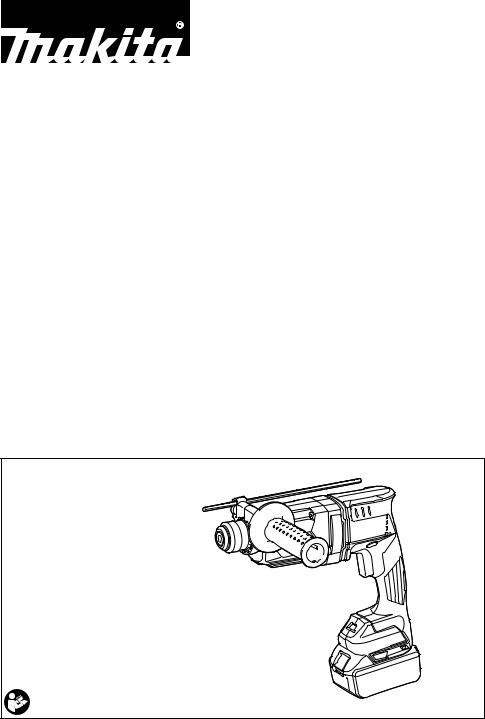
|
|
Cordless Combination |
INSTRUCTION MANUAL |
11 |
|
EN |
|||
|
Hammer |
|||
|
|
|
|
|
|
|
Marteau Combiné sans Fil |
MANUEL D’INSTRUCTIONS |
24 |
|
FR |
|||
|
|
|
|
|
|
|
Akku-Kombi-Bohrhammer |
BETRIEBSANLEITUNG |
38 |
|
DE |
|||
|
|
|
|
|
|
|
Tassellatore combinato a |
ISTRUZIONI PER L’USO |
54 |
|
IT |
|||
|
batteria |
|||
|
|
|
|
|
|
|
Accucombihamer |
GEBRUIKSAANWIJZING |
70 |
|
NL |
|||
|
|
|
|
|
|
|
Martillo Rotativo Combinado |
MANUAL DE |
85 |
|
ES |
|||
|
Inalámbrico |
INSTRUCCIONES |
||
|
|
|
||
|
|
Martelete Combinado A |
MANUAL DE INSTRUÇÕES |
100 |
|
PT |
|||
|
Bateria |
|||
|
|
|
|
|
|
|
Akku-kombinationshammer |
BRUGSANVISNING |
115 |
|
DA |
|||
|
|
|
|
|
|
|
Φορητό δράπανο |
ΕΓΧΕΙΡΙΔΙΟ ΟΔΗΓΙΩΝ |
128 |
|
EL |
|||
|
συνδυασμού |
|||
|
|
|
|
|
|
|
Kablosuz Kombine Darbeli |
KULLANMA KILAVUZU |
144 |
|
TR |
|||
|
Matkap |
|||
|
|
|
|
DHR182
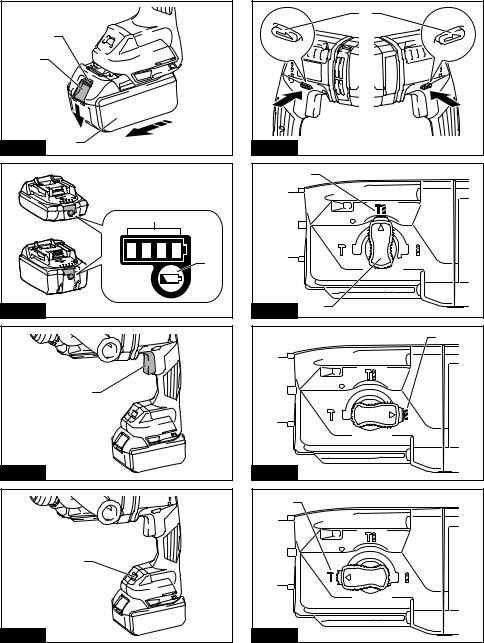
|
1 |
|
2 |
Fig.1 |
3 |
|
1 |
2 |
Fig.2 |
1 |
Fig.3 |
1 |
Fig.4 |
|
1 |
A |
B |
Fig.5 |
|
|
1 |
Fig.6 |
2 |
|
|
|
1 |
Fig.7 |
|
|
1 |
Fig.8
2
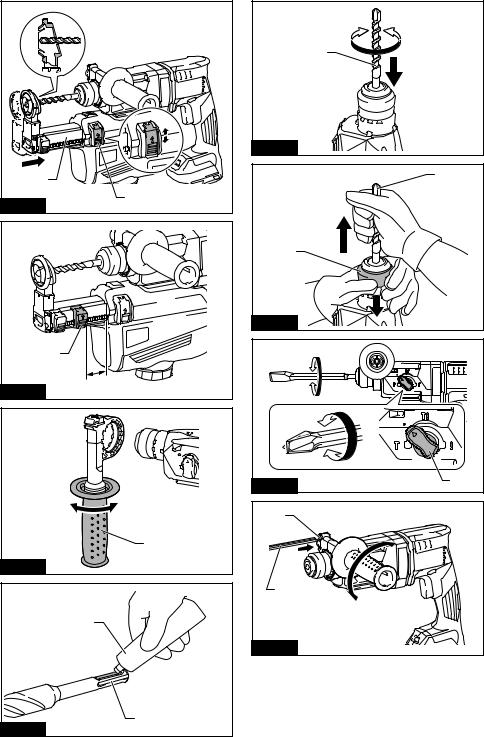
|
1 |
Fig.9 |
2 |
|
|
1 |
Fig.10 |
A |
|
1 |
Fig.11 |
2 |
1
Fig.12
3
1 |
Fig.13 |
1 |
|
2 |
Fig.14 |
|
Fig.15 |
1 |
|
|
1 |
|
2 |
|
Fig.16 |
|
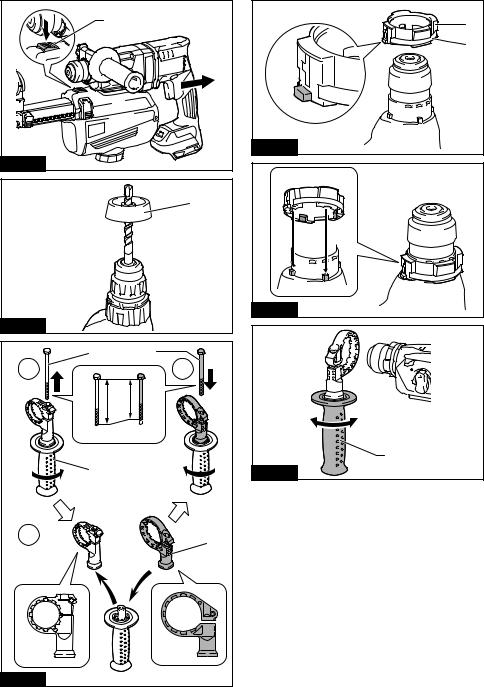
1 |
1 |
|
|
|
2 |
|
Fig.20 |
Fig.17 |
|
|
1 |
|
Fig.21 |
Fig.18 |
|
1 |
3 |
1 |
3 |
|
1 |
2 |
Fig.22 |
2 |
3 |
|
|
Fig.19 |
|
|
4 |
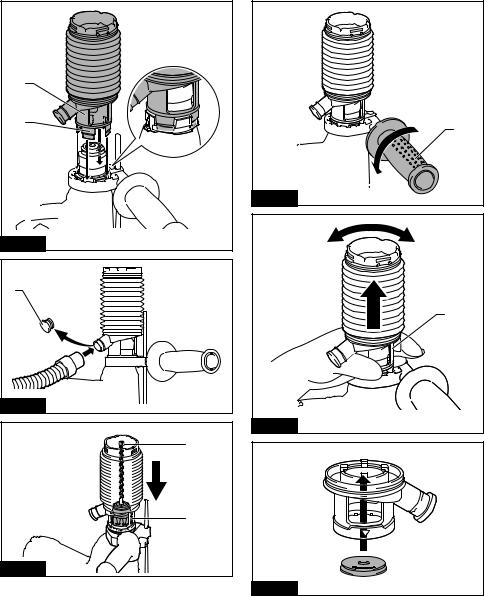
1 |
2 |
Fig.23 |
1 |
Fig.24 |
1 |
2 |
Fig.25 |
1 |
Fig.26 |
1 |
Fig.27 |
Fig.28 |
5
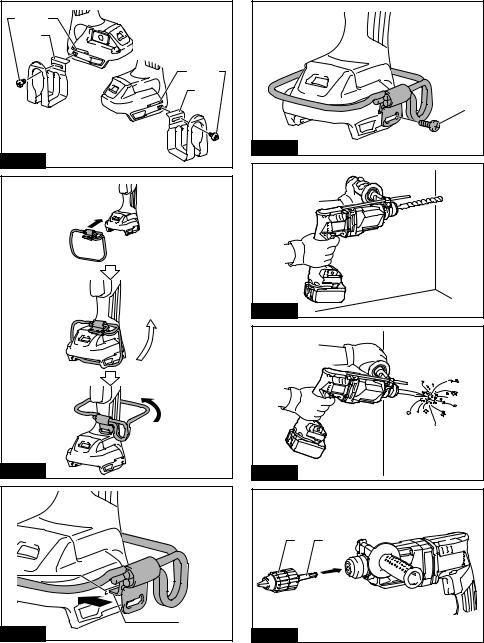
3 |
1 |
|
|
2 |
|
|
1 |
3 |
|
|
2 |
Fig.29 |
|
|
Fig.30 |
1 |
2 |
Fig.31 |
1 |
Fig.32 |
Fig.33 |
Fig.34 |
1 |
2 |
Fig.35 |
|
6
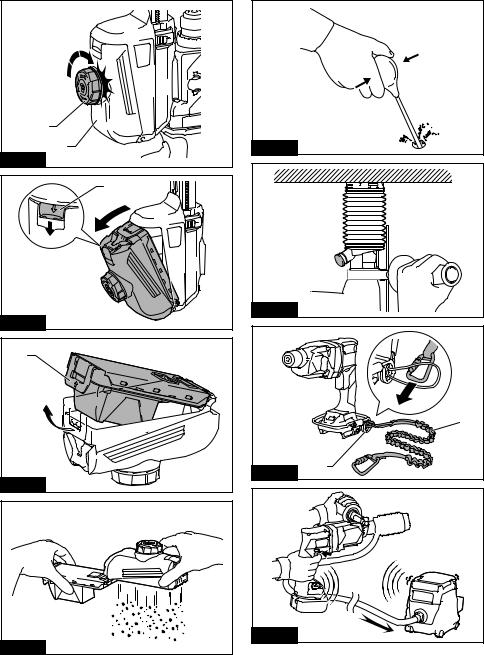
2 |
|
|
1 |
Fig.40 |
|
Fig.36 |
|
|
|
1 |
|
Fig.37 |
Fig.41 |
|
|
|
|
1 |
|
|
|
|
2 |
|
Fig.42 |
1 |
Fig.38 |
|
|
|
|
|
Fig.39 |
Fig.43 |
|
|
|
7
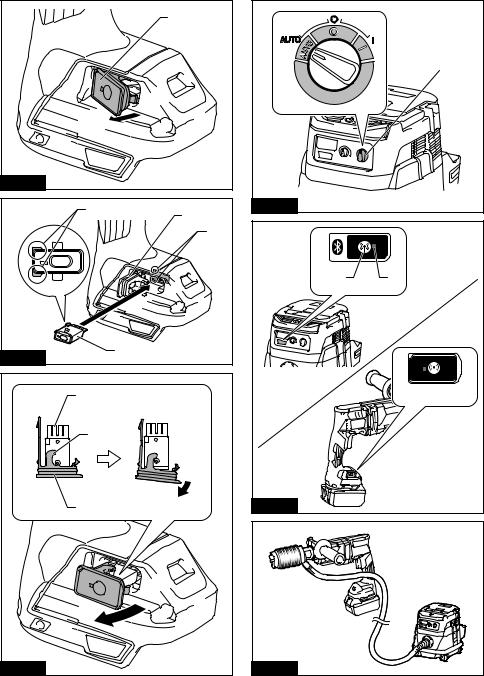
|
1 |
Fig.44 |
|
2 |
3 |
|
|
|
4 |
Fig.45 |
1 |
|
|
|
1 |
|
2 |
|
3 |
Fig.46 |
|
|
8 |
|
1 |
Fig.47 |
|
1 |
2 |
2
 1
1
Fig.48 |
Fig.49 |
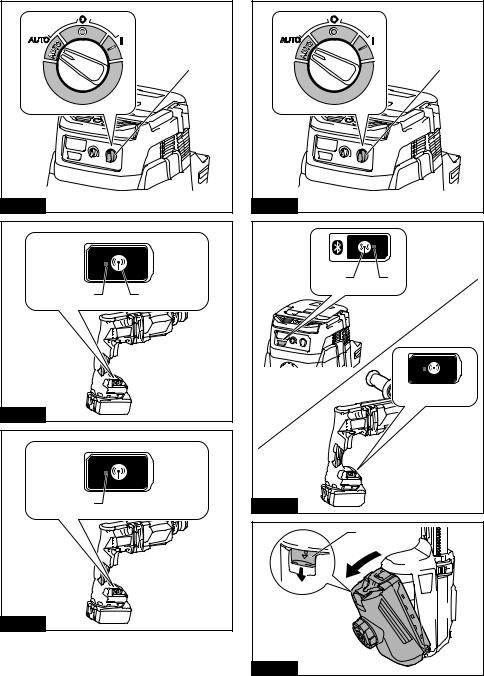
1 |
Fig.50 |
2 |
1 |
Fig.51 |
|
1 |
Fig.52 |
|
1 |
Fig.53 |
|
1 |
2 |
2
 1
1
Fig.54 |
1 |
Fig.55 |
9
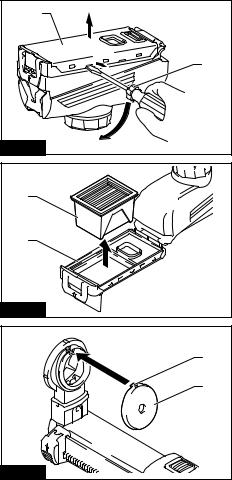
2 |
1 |
Fig.56 |
1 |
2 |
Fig.57 |
1 |
2 |
Fig.58 |
10

ENGLISH (Original instructions)
SPECIFICATIONS
Model: |
|
DHR182 |
Capacities |
Concrete |
18 mm |
|
Core bit |
35 mm |
|
Diamond core bit (dry type) |
32 mm |
|
Steel |
13 mm |
|
Wood |
24 mm |
No load speed |
|
0 - 1,350 min-1 |
Blows per minute |
|
0 - 5,000 min-1 |
Overall length |
|
301 mm |
Rated voltage |
|
D.C. 18 V |
Net weight |
|
2.4 - 3.2 kg |
Optional accessory |
|
|
Model: |
DX05 |
Suction performance |
250 l/min |
Operating stroke |
Up to 90 mm |
Suitable drill bit |
Up to 160 mm |
Net weight |
0.9 kg |
•Due to our continuing program of research and development, the specifications herein are subject to change without notice.
•Specifications and battery cartridge may differ from country to country.
•The weight may differ depending on the attachment(s), including the battery cartridge. The lightest and heaviest combinations, according to EPTA-Procedure 01/2014, are shown in the table.
Applicable battery cartridge
BL1815N / BL1820 / BL1820B / BL1830 / BL1830B / BL1840 / BL1840B / BL1850 / BL1850B / BL1860B
•Some of the battery cartridges listed above may not be available depending on your region of residence.
 WARNING: Only use the battery cartridges listed above. Use of any other battery cartridges may cause injury and/or fire.
WARNING: Only use the battery cartridges listed above. Use of any other battery cartridges may cause injury and/or fire.
Intended use
The tool is intended for hammer drilling and drilling in brick, concrete and stone as well as for chiselling work. It is also suitable for drilling without impact in wood, metal, ceramic and plastic.
Noise
The typical A-weighted noise level determined according to EN60745-2-6:
Model DHR182
Sound pressure level (LpA) : 89 dB(A) Sound power level (LWA) : 100 dB (A) Uncertainty (K) : 3 dB(A)
Model DHR182 with DX05
Sound pressure level (LpA) : 90 dB(A) Sound power level (LWA) : 101 dB (A) Uncertainty (K) : 3 dB(A)
NOTE: The declared noise emission value(s) has been measured in accordance with a standard test method and may be used for comparing one tool with another.
NOTE: The declared noise emission value(s) may also be used in a preliminary assessment of exposure.
 WARNING: Wear ear protection.
WARNING: Wear ear protection.
 WARNING: The noise emission during actual use of the power tool can differ from the declared value(s) depending on the ways in which the tool is used especially what kind of workpiece is processed.
WARNING: The noise emission during actual use of the power tool can differ from the declared value(s) depending on the ways in which the tool is used especially what kind of workpiece is processed.
 WARNING: Be sure to identify safety measures to protect the operator that are based on an estimation of exposure in the actual conditions of use (taking account of all parts of the operating cycle such as the times when the tool is switched off and when it is running idle in addition to the trigger time).
WARNING: Be sure to identify safety measures to protect the operator that are based on an estimation of exposure in the actual conditions of use (taking account of all parts of the operating cycle such as the times when the tool is switched off and when it is running idle in addition to the trigger time).
11 ENGLISH
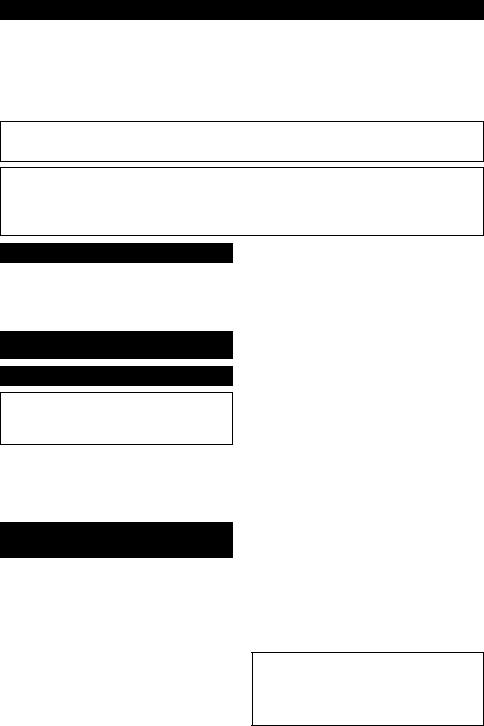
Vibration
The following table shows the vibration total value (tri-axial vector sum) determined according to applicable standard.
Work mode |
Vibration emission |
Uncertainty (K) |
Applicable standard |
Hammer drilling into concrete (ah, HD) |
11.0 m/s2 |
1.5 m/s2 |
EN60745-2-6 |
Hammer drilling into concrete with DX05 (ah, HD) |
11.0 m/s2 |
1.5 m/s2 |
EN60745-2-6 |
Chiselling function with side grip (ah, Cheq) |
9.0 m/s2 |
1.5 m/s2 |
EN60745-2-6 |
Drilling into metal (ah, D) |
2.5 m/s2 |
1.5 m/s2 |
EN60745-2-1 |
NOTE: The declared vibration total value(s) has been measured in accordance with a standard test method and may be used for comparing one tool with another.
NOTE: The declared vibration total value(s) may also be used in a preliminary assessment of exposure.
 WARNING: The vibration emission during actual use of the power tool can differ from the declared value(s) depending on the ways in which the tool is used especially what kind of workpiece is processed.
WARNING: The vibration emission during actual use of the power tool can differ from the declared value(s) depending on the ways in which the tool is used especially what kind of workpiece is processed.
 WARNING: Be sure to identify safety measures to protect the operator that are based on an estimation of exposure in the actual conditions of use (taking account of all parts of the operating cycle such as the times when the tool is switched off and when it is running idle in addition to the trigger time).
WARNING: Be sure to identify safety measures to protect the operator that are based on an estimation of exposure in the actual conditions of use (taking account of all parts of the operating cycle such as the times when the tool is switched off and when it is running idle in addition to the trigger time).
EC Declaration of Conformity
For European countries only
The EC declaration of conformity is included as Annex A to this instruction manual.
SAFETY WARNINGS
General power tool safety warnings
 WARNING: Read all safety warnings, instructions, illustrations and specifications provided with this power tool. Failure to follow all instructions listed below may result in electric shock, fire and/or serious injury.
WARNING: Read all safety warnings, instructions, illustrations and specifications provided with this power tool. Failure to follow all instructions listed below may result in electric shock, fire and/or serious injury.
Save all warnings and instructions for future reference.
The term "power tool" in the warnings refers to your mains-operated (corded) power tool or battery-operated (cordless) power tool.
CORDLESS ROTARY HAMMER SAFETY WARNINGS
1.Wear ear protectors. Exposure to noise can cause hearing loss.
2.Use auxiliary handle(s), if supplied with the tool. Loss of control can cause personal injury.
3.Hold power tool by insulated gripping surfaces, when performing an operation where the cutting accessory may contact hidden wiring.
Cutting accessory contacting a "live" wire may make exposed metal parts of the power tool "live" and could give the operator an electric shock.
4.Wear a hard hat (safety helmet), safety glasses and/or face shield. Ordinary eye or sun glasses are NOT safety glasses. It is also highly recommended that you wear a dust mask and thickly padded gloves.
5.Be sure the bit is secured in place before operation.
6.Under normal operation, the tool is designed to produce vibration. The screws can come loose easily, causing a breakdown or accident. Check tightness of screws carefully before operation.
7.In cold weather or when the tool has not been used for a long time, let the tool warm up for a while by operating it under no load. This will loosen up the lubrication. Without proper warm-up, hammering operation is difficult.
8.Always be sure you have a firm footing. Be sure no one is below when using the tool in high locations.
9.Hold the tool firmly with both hands.
10.Keep hands away from moving parts.
11.Do not leave the tool running. Operate the tool only when hand-held.
12.Do not point the tool at any one in the area when operating. The bit could fly out and injure someone seriously.
13.Do not touch the bit, parts close to the bit, or workpiece immediately after operation; they may be extremely hot and could burn your skin.
14.Some material contains chemicals which may be toxic. Take caution to prevent dust inhalation and skin contact. Follow material supplier safety data.
15.Always be sure that the tool is switched off and the battery cartridge and the bit are removed before handing the tool to other person.
SAVE THESE INSTRUCTIONS.
 WARNING: DO NOT let comfort or familiarity with product (gained from repeated use) replace strict adherence to safety rules for the subject product. MISUSE or failure to follow the safety rules stated in this instruction manual may cause serious personal injury.
WARNING: DO NOT let comfort or familiarity with product (gained from repeated use) replace strict adherence to safety rules for the subject product. MISUSE or failure to follow the safety rules stated in this instruction manual may cause serious personal injury.
12 ENGLISH

Important safety instructions for battery cartridge
1.Before using battery cartridge, read all instructions and cautionary markings on (1) battery charger, (2) battery, and (3) product using battery.
2.Do not disassemble battery cartridge.
3.If operating time has become excessively shorter, stop operating immediately. It may result in a risk of overheating, possible burns and even an explosion.
4.If electrolyte gets into your eyes, rinse them out with clear water and seek medical attention right away. It may result in loss of your eyesight.
5.Do not short the battery cartridge:
(1)Do not touch the terminals with any conductive material.
(2)Avoid storing battery cartridge in a container with other metal objects such as nails, coins, etc.
(3)Do not expose battery cartridge to water or rain.
Abattery short can cause a large current flow, overheating, possible burns and even a breakdown.
6.Do not store the tool and battery cartridge in locations where the temperature may reach or exceed 50 °C (122 °F).
7.Do not incinerate the battery cartridge even if it is severely damaged or is completely worn out. The battery cartridge can explode in a fire.
8.Be careful not to drop or strike battery.
9.Do not use a damaged battery.
10.The contained lithium-ion batteries are subject to the Dangerous Goods Legislation requirements.
For commercial transports e.g. by third parties, forwarding agents, special requirement on packaging and labeling must be observed.
For preparation of the item being shipped, consulting an expert for hazardous material is required. Please also observe possibly more detailed national regulations. Tape or mask off open contacts and pack up the battery in such a manner that it cannot move around in the packaging.
11.Follow your local regulations relating to disposal of battery.
12.Use the batteries only with the products specified by Makita. Installing the batteries to non-compliant products may result in a fire, excessive heat, explosion, or leak of electrolyte.
SAVE THESE INSTRUCTIONS.
 CAUTION: Only use genuine Makita batteries.
CAUTION: Only use genuine Makita batteries.
Use of non-genuine Makita batteries, or batteries that have been altered, may result in the battery bursting causing fires, personal injury and damage. It will also void the Makita warranty for the Makita tool and charger.
Tips for maintaining maximum battery life
1.Charge the battery cartridge before completely discharged. Always stop tool operation and charge the battery cartridge when you notice less tool power.
2.Never recharge a fully charged battery cartridge. Overcharging shortens the battery service life.
3.Charge the battery cartridge with room temperature at 10 °C - 40 °C (50 °F - 104 °F). Let a hot battery cartridge cool down before charging it.
4.Charge the battery cartridge if you do not use it for a long period (more than six months).
Important safety instructions for wireless unit
1.Do not disassemble or tamper with the wireless unit.
2.Keep the wireless unit away from young children. If accidentally swallowed, seek medical attention immediately.
3.Use the wireless unit only with Makita tools.
4.Do not expose the wireless unit to rain or wet conditions.
5.Do not use the wireless unit in places where the temperature exceeds 50°C (122°F).
6.Do not operate the wireless unit in places where medical instruments, such as heart pace makers are nearby.
7.Do not operate the wireless unit in places where automated devices are nearby. If operated, automated devices may develop malfunction or error.
8.Do not operate the wireless unit in places under high temperature or places where static electricity or electrical noise could be generated.
9.The wireless unit can produce electromagnetic fields (EMF) but they are not harmful to the user.
10.The wireless unit is an accurate instrument. Be careful not to drop or strike the wireless unit.
11.Avoid touching the terminal of the wireless unit with bare hands or metallic materials.
12.Always remove the battery on the product when installing the wireless unit into it.
13.When opening the lid of the slot, avoid the place where dust and water may come into the slot. Always keep the inlet of the slot clean.
14.Always insert the wireless unit in the correct direction.
15.Do not press the wireless activation button on the wireless unit too hard and/or press the button with an object with a sharp edge.
16.Always close the lid of the slot when operating.
17.Do not remove the wireless unit from the slot while the power is being supplied to the tool.
Doing so may cause a malfunction of the wireless unit.
18.Do not remove the sticker on the wireless unit.
19.Do not put any sticker on the wireless unit.
20.Do not leave the wireless unit in a place where static electricity or electrical noise could be generated.
21.Do not leave the wireless unit in a place subject to high heat, such as a car sitting in the sun.
22.Do not leave the wireless unit in a dusty or powdery place or in a place corrosive gas could be generated.
23.Sudden change of the temperature may bedew the wireless unit. Do not use the wireless unit until the dew is completely dried.
24.When cleaning the wireless unit, gently wipe with a dry soft cloth. Do not use benzine, thinner, conductive grease or the like.
25.When storing the wireless unit, keep it in the supplied case or a static-free container.
26.Do not insert any devices other than Makita wireless unit into the slot on the tool.
13 ENGLISH

27.Do not use the tool with the lid of the slot damaged. Water, dust, and dirt come into the slot may cause malfunction.
28.Do not pull and/or twist the lid of the slot more than necessary. Restore the lid if it comes off from the tool.
29.Replace the lid of the slot if it is lost or damaged.
SAVE THESE INSTRUCTIONS.
FUNCTIONAL
DESCRIPTION
 CAUTION: Always be sure that the tool is switched off and the battery cartridge is removed before adjusting or checking function on the tool.
CAUTION: Always be sure that the tool is switched off and the battery cartridge is removed before adjusting or checking function on the tool.
Installing or removing battery cartridge
 CAUTION: Always switch off the tool before installing or removing of the battery cartridge.
CAUTION: Always switch off the tool before installing or removing of the battery cartridge.
 CAUTION: Hold the tool and the battery cartridge firmly when installing or removing battery cartridge. Failure to hold the tool and the battery cartridge firmly may cause them to slip off your hands and result in damage to the tool and battery cartridge and a personal injury.
CAUTION: Hold the tool and the battery cartridge firmly when installing or removing battery cartridge. Failure to hold the tool and the battery cartridge firmly may cause them to slip off your hands and result in damage to the tool and battery cartridge and a personal injury.
► Fig.1: 1. Red indicator 2. Button 3. Battery cartridge
To remove the battery cartridge, slide it from the tool while sliding the button on the front of the cartridge.
To install the battery cartridge, align the tongue on the battery cartridge with the groove in the housing and slip it into place. Insert it all the way until it locks in place with a little click. If you can see the red indicator on the upper side of the button, it is not locked completely.
 CAUTION: Always install the battery cartridge fully until the red indicator cannot be seen. If not, it may accidentally fall out of the tool, causing injury to you or someone around you.
CAUTION: Always install the battery cartridge fully until the red indicator cannot be seen. If not, it may accidentally fall out of the tool, causing injury to you or someone around you.
 CAUTION: Do not install the battery cartridge forcibly. If the cartridge does not slide in easily, it is not being inserted correctly.
CAUTION: Do not install the battery cartridge forcibly. If the cartridge does not slide in easily, it is not being inserted correctly.
Indicating the remaining battery capacity
Only for battery cartridges with the indicator
► Fig.2: 1. Indicator lamps 2. Check button
Press the check button on the battery cartridge to indicate the remaining battery capacity. The indicator lamps light up for a few seconds.
|
Indicator lamps |
Remaining |
|
|
capacity |
Lighted |
Off |
Blinking |
|
|
75% to 100% |
|
|
50% to 75% |
|
|
25% to 50% |
|
|
0% to 25% |
|
|
Charge the |
|
|
battery. |
|
|
The battery |
|
|
may have |
|
|
malfunctioned. |
NOTE: Depending on the conditions of use and the ambient temperature, the indication may differ slightly from the actual capacity.
Tool / battery protection system
The tool is equipped with a tool/battery protection system. This system automatically cuts off power to the motor to extend tool and battery life. The tool will automatically stop during operation if the tool or battery is placed under one of the following conditions:
Overload protection
When the battery is operated in a manner that causes it to draw an abnormally high current, the tool automatically stops without any indication. In this situation, turn the tool off and stop the application that caused the tool to become overloaded. Then turn the tool on to restart.
Overheat protection
When the tool or battery is overheated, the tool stops automatically. In this case, let the tool and battery cool before turning the tool on again.
NOTE: When the tool is overheated, the lamp blinks.
Overdischarge protection
When the battery capacity is not enough, the tool stops automatically. In this case, remove the battery from the tool and charge the battery.
14 ENGLISH

Switch action
 WARNING: Before installing the battery cartridge into the tool, always check to see that the switch trigger actuates properly and returns to the "OFF" position when released.
WARNING: Before installing the battery cartridge into the tool, always check to see that the switch trigger actuates properly and returns to the "OFF" position when released.
► Fig.3: 1. Switch trigger
To start the tool, simply pull the switch trigger. Tool speed is increased by increasing pressure on the switch trigger. Release the switch trigger to stop.
Lighting up the front lamp
► Fig.4: 1. Lamp
 CAUTION: Do not look in the light or see the source of light directly.
CAUTION: Do not look in the light or see the source of light directly.
Pull the switch trigger to light up the lamp. The lamp keeps on lighting while the switch trigger is being pulled. The lamp goes out approximately 10 seconds after releasing the switch trigger.
NOTE: Use a dry cloth to wipe the dirt off the lens of the lamp. Be careful not to scratch the lens of lamp, or it may lower the illumination.
Reversing switch action
► Fig.5: 1. Reversing switch lever
 CAUTION: Always check the direction of rotation before operation.
CAUTION: Always check the direction of rotation before operation.
 CAUTION: Use the reversing switch only after the tool comes to a complete stop. Changing the direction of rotation before the tool stops may damage the tool.
CAUTION: Use the reversing switch only after the tool comes to a complete stop. Changing the direction of rotation before the tool stops may damage the tool.
 CAUTION: When not operating the tool, always set the reversing switch lever to the neutral position.
CAUTION: When not operating the tool, always set the reversing switch lever to the neutral position.
This tool has a reversing switch to change the direction of rotation. Depress the reversing switch lever from the A side for clockwise rotation or from the B side for counterclockwise rotation. When the reversing switch lever is in the neutral position, the switch trigger cannot be pulled.
Selecting the action mode
NOTICE: Do not rotate the action mode changing knob when the tool is running. The tool will be damaged.
NOTICE: To avoid rapid wear on the mode change mechanism, be sure that the action mode changing knob is always positively located in one of the three action mode positions.
Rotation with hammering
For drilling in concrete, masonry, etc., rotate the action
mode changing knob to the  symbol. Use a tungstencarbide tipped bit (optional accessory).
symbol. Use a tungstencarbide tipped bit (optional accessory).
► Fig.6: 1. Rotation with hammering 2. Action mode changing knob
Rotation only
For drilling in wood, metal or plastic materials, rotate
the action mode changing knob to the  symbol. Use a twist drill bit or wood drill bit.
symbol. Use a twist drill bit or wood drill bit.
► Fig.7: 1. Rotation only
Hammering only
For chipping, scaling or demolition operations, rotate
the action mode changing knob to the  symbol. Use a bull point, cold chisel, scaling chisel, etc.
symbol. Use a bull point, cold chisel, scaling chisel, etc.
► Fig.8: 1. Hammering only
Adjusting the nozzle position of the dust collection system
Optional accessory
Push in the guide while pushing up the guide adjustment button, and then release the button at the desired position.
► Fig.9: 1. Guide 2. Guide adjustment button
NOTE: Before adjusting the nozzle position, release the nozzle forward completely by pushing up the guide adjustment button.
Adjusting the drilling depth of the dust collection system
Optional accessory
Slide the depth adjustment button to the desired position while pushing it up. The distance (A) is the drilling depth.
► Fig.10: 1. Depth adjustment button
Torque limiter
NOTICE: As soon as the torque limiter actuates, switch off the tool immediately. This will help prevent premature wear of the tool.
NOTICE: Drill bits such as hole saw, which tend to pinch or catch easily in the hole, are not appropriate for this tool. This is because they will cause the torque limiter to actuate too frequently.
The torque limiter will actuate when a certain torque level is reached. The motor will disengage from the output shaft. When this happens, the drill bit will stop turning.
Electronic function
The tool is equipped with the electronic functions for easy operation.
•Constant speed control
The speed control function provides the constant rotation speed regardless of load conditions.
15 ENGLISH

ASSEMBLY
 CAUTION: Always be sure that the tool is switched off and the battery cartridge is removed before carrying out any work on the tool.
CAUTION: Always be sure that the tool is switched off and the battery cartridge is removed before carrying out any work on the tool.
Side grip (auxiliary handle)
 CAUTION: Always use the side grip to ensure safe operation.
CAUTION: Always use the side grip to ensure safe operation.
 CAUTION: After installing or adjusting the side grip, make sure that the side grip is firmly secured.
CAUTION: After installing or adjusting the side grip, make sure that the side grip is firmly secured.
Install the side grip so that the grooves on the grip fit in the protrusions on the tool barrel. Turn the grip clockwise to secure it. The grip can be fixed at desired angle. ► Fig.11: 1. Side grip
Grease
Coat the shank end of the drill bit beforehand with a small amount of grease (about 0.5 - 1 g).
This chuck lubrication assures smooth action and longer service life.
Installing or removing drill bit
Clean the shank end of the drill bit and apply grease before installing the drill bit.
► Fig.12: 1. Shank end 2. Grease
Insert the drill bit into the tool. Turn the drill bit and push it in until it engages.
After installing the drill bit, always make sure that the drill bit is securely held in place by trying to pull it out.
► Fig.13: 1. Drill bit
To remove the drill bit, pull the chuck cover down all the way and pull the drill bit out.
► Fig.14: 1. Drill bit 2. Chuck cover
Chisel angle (when chipping, scaling or demolishing)
The chisel can be secured at the desired angle. To change the chisel angle, rotate the action mode changing knob to the O symbol. Turn the chisel to the desired angle.
► Fig.15: 1. Action mode changing knob
Rotate the action mode changing knob to the  symbol. Then make sure that the chisel is securely held in place by turning it slightly.
symbol. Then make sure that the chisel is securely held in place by turning it slightly.
Depth gauge
The depth gauge is convenient for drilling holes of uniform depth. Loosen the side grip and insert the depth gauge into the hole on the side grip.Adjust the depth gauge to the desired depth and tighten the side grip firmly.
► Fig.16: 1. Hole 2. Depth gauge
NOTE: Make sure that the depth gauge does not touch the main body of the tool when attaching it.
Installing or removing dust collection system
Optional accessory
To remove the dust collection system, pull the tool while pressing the lock-off button. To install it, insert the tool into the dust collection system all the way until it locks in place with a little click.
► Fig.17: 1. Lock-off button
Dust cup
Optional accessory
Use the dust cup to prevent dust from falling over the tool and on yourself when performing overhead drilling operations.
Attach the dust cup to the bit as shown in the figure. The size of bits which the dust cup can be attached to is as follows.
Model |
Bit diameter |
Dust cup 5 |
6 mm - 14.5 mm |
Dust cup 9 |
12 mm - 16 mm |
► Fig.18: 1. Dust cup
Dust cup set
Optional accessory
Installing the dust cup set
NOTICE: If you purchase the dust cup set as optional accessory, the standard side grip cannot be used with the dust cup set being installed on the tool. When the dust cup set is installed on the tool, remove the grip from the standard side grip, and then attach it to the optional grip base set.
► Fig.19: 1. Bolt 2. Grip 3. Optional grip base set
NOTICE: Do not use the dust cup set when drilling in metal or similar. It may damage the dust cup set due to the heat produced by small metal dust or similar. Do not install or remove the dust cup set with the drill bit installed in the tool. It may damage the dust cup set and cause dust leak.
Before installing the dust cup set, remove the bit from the tool if installed.
1. Install the spacer so that the grooves on the spacer fit in the protrusions on the tool barrel while widening it. Be careful for the spring not to come off from the slit of spacer.
►Fig.20: 1. Spacer 2. Spring
►Fig.21
2.Install the side grip (optional grip base set and the grip removed from standard side grip) so that the groove on the grip fit in the protrusion on the spacer.
Turn the grip clockwise to secure it.
► Fig.22: 1. Side grip
3.Install the dust cup set so that the claws of the dust cup fit in in the slits on the spacer.
► Fig.23: 1. Dust cup 2. Claws
NOTE: If you connect a vacuum cleaner to the dust cup set, remove the dust cap before connecting it.
► Fig.24: 1. Dust cap
16 ENGLISH

Removing the drill bit
To remove the drill bit, pull the chuck cover down all the way and pull the drill bit out.
► Fig.25: 1. Bit 2. Chuck cover
Removing the dust cup set
To remove the dust cup set, follow the steps below.
1.Loosen the side grip.
► Fig.26: 1. Side grip
2.Hold the root of dust cup and pull it out.
► Fig.27: 1. Dust cup
NOTE: If it is difficult to remove the dust cup set, remove the claws of the dust cup one by one by swinging and pulling the root of the dust cup.
NOTE: If the cap comes off from the dust cup, attach it with its printed side facing up so that groove on the cap fits in the inside periphery of the attachment.
► Fig.28
Hook
Optional accessory
 CAUTION: Always remove the battery when hanging the tool with the hook.
CAUTION: Always remove the battery when hanging the tool with the hook.
 CAUTION: Never hook the tool at high location or on potentially unstable surface.
CAUTION: Never hook the tool at high location or on potentially unstable surface.
► Fig.29: 1. Groove 2. Hook 3. Screw
The hook is convenient for temporarily hanging the tool. This can be installed on either side of the tool.
To install the hook, insert it into a groove in the tool housing on either side and then secure it with a screw. To remove, loosen the screw and then take it out.
Tool hanger
Optional accessory
 CAUTION: Do not use damaged tool hanger and screw. Before use, always check for damages, cracks or deformations, and make sure that the screw is tightened.
CAUTION: Do not use damaged tool hanger and screw. Before use, always check for damages, cracks or deformations, and make sure that the screw is tightened.
 CAUTION: Install or remove the tool hanger on a stable table or surface. Be sure to use the screw provided with the tool hanger only. After installing the tool hanger, make sure that the tool hanger is securely installed with the screw.
CAUTION: Install or remove the tool hanger on a stable table or surface. Be sure to use the screw provided with the tool hanger only. After installing the tool hanger, make sure that the tool hanger is securely installed with the screw.
 CAUTION: Do not remove the battery cartridge while hanging the tool. The tool may fall if the screw is not tightened.
CAUTION: Do not remove the battery cartridge while hanging the tool. The tool may fall if the screw is not tightened.
The tool hanger is intended for connecting the lanyard (tether strap). To install the tool hanger to the tool, follow the steps below.
1.Remove the battery cartridge from the tool.
2.Attach the tool hanger from the bottom of the tool as shown in the figure.
► Fig.30
3. Insert the protrusion of the tool hanger into the groove on the left side of the tool.
► Fig.31: 1. Groove 2. Protrusion
NOTE: The tool hanger can be installed in the direction as shown in the figure only.
4. Tighten the screw firmly. ► Fig.32: 1. Screw
OPERATION
 CAUTION: Always use the side grip (auxiliary handle) and firmly hold the tool by both side grip and switch handle during operations.
CAUTION: Always use the side grip (auxiliary handle) and firmly hold the tool by both side grip and switch handle during operations.
 CAUTION: Always make sure that the workpiece is secured before operation.
CAUTION: Always make sure that the workpiece is secured before operation.
 CAUTION: Do not pull the tool out forcibly even the bit gets stuck. Loss of control may cause injury.
CAUTION: Do not pull the tool out forcibly even the bit gets stuck. Loss of control may cause injury.
 CAUTION: The dust collection system is intended for drilling in concrete only. Do not use the dust collection system for drilling in metal or wood.
CAUTION: The dust collection system is intended for drilling in concrete only. Do not use the dust collection system for drilling in metal or wood.
 CAUTION: When using the tool with the dust collection system, be sure to attach the filter to the dust collection system to prevent dust inhalation.
CAUTION: When using the tool with the dust collection system, be sure to attach the filter to the dust collection system to prevent dust inhalation.
 CAUTION: Before using the dust collection system, check that the filter is not damaged.
CAUTION: Before using the dust collection system, check that the filter is not damaged.
Failure to do so may cause dust inhalation.
 CAUTION: The dust collection system collects the generated dust at a considerable rate, but not all dust can be collected.
CAUTION: The dust collection system collects the generated dust at a considerable rate, but not all dust can be collected.
NOTICE: Do not use the dust collection system for core drilling or chiseling.
NOTICE: Do not use the dust collection system for drilling in wet concrete or use this system in wet environment. Failure to do so may cause malfunction.
NOTE: If the battery cartridge is in low temperature, the tool’s capability may not be fully obtained. In this case, warm up the battery cartridge by using the tool with no load for a while to fully obtain the tool’s capability.
► Fig.33
Hammer drilling operation
 CAUTION: There is tremendous and sudden twisting force exerted on the tool/drill bit at the time of hole break-through, when the hole becomes clogged with chips and particles, or when striking reinforcing rods embedded in the concrete. Always use the side grip (auxiliary handle) and firmly hold the tool by both side grip and switch handle during operations. Failure to do so may result in the loss of control of the tool and potentially severe injury.
CAUTION: There is tremendous and sudden twisting force exerted on the tool/drill bit at the time of hole break-through, when the hole becomes clogged with chips and particles, or when striking reinforcing rods embedded in the concrete. Always use the side grip (auxiliary handle) and firmly hold the tool by both side grip and switch handle during operations. Failure to do so may result in the loss of control of the tool and potentially severe injury.
17 ENGLISH

Set the action mode changing knob to the  symbol. Position the drill bit at the desired location for the hole, then pull the switch trigger. Do not force the tool. Light pressure gives best results. Keep the tool in position and prevent it from slipping away from the hole.
symbol. Position the drill bit at the desired location for the hole, then pull the switch trigger. Do not force the tool. Light pressure gives best results. Keep the tool in position and prevent it from slipping away from the hole.
Do not apply more pressure when the hole becomes clogged with chips or particles. Instead, run the tool at an idle, then remove the drill bit partially from the hole. By repeating this several times, the hole will be cleaned out and normal drilling may be resumed.
NOTE: Eccentricity in the drill bit rotation may occur while operating the tool with no load. The tool automatically centers itself during operation. This does not affect the drilling precision.
Chipping/Scaling/Demolition
Set the action mode changing knob to the  symbol.
symbol.
Hold the tool firmly with both hands. Turn the tool on and apply slight pressure on the tool so that the tool will not bounce around, uncontrolled.
Pressing very hard on the tool will not increase the efficiency.
► Fig.34
Drilling in wood or metal
 CAUTION: Hold the tool firmly and exert care when the drill bit begins to break through the workpiece. There is a tremendous force exerted on the tool/drill bit at the time of hole break through.
CAUTION: Hold the tool firmly and exert care when the drill bit begins to break through the workpiece. There is a tremendous force exerted on the tool/drill bit at the time of hole break through.

 CAUTION: A stuck drill bit can be removed simply by setting the reversing switch to reverse rotation in order to back out. However, the tool may back out abruptly if you do not hold it firmly.
CAUTION: A stuck drill bit can be removed simply by setting the reversing switch to reverse rotation in order to back out. However, the tool may back out abruptly if you do not hold it firmly.
 CAUTION: Always secure workpieces in a vise or similar hold-down device.
CAUTION: Always secure workpieces in a vise or similar hold-down device.
NOTICE: Never use “rotation with hammering” when the drill chuck is installed on the tool. The drill chuck may be damaged.
Also, the drill chuck will come off when reversing the tool.
NOTICE: Pressing excessively on the tool will not speed up the drilling. In fact, this excessive pressure will only serve to damage the tip of your drill bit, decrease the tool performance and shorten the service life of the tool.
Set the action mode changing knob to the  symbol. Attach the chuck adapter to a keyless drill chuck to which 1/2"-20 size screw can be installed, and then install them to the tool. When installing it, refer to the section “Installing or removing drill bit”.
symbol. Attach the chuck adapter to a keyless drill chuck to which 1/2"-20 size screw can be installed, and then install them to the tool. When installing it, refer to the section “Installing or removing drill bit”.
► Fig.35: 1. Drill chuck assembly 2. Chuck adapter
Diamond core drilling
NOTICE: If performing diamond core drilling operations using “rotation with hammering” action, the diamond core bit may be damaged.
When performing diamond core drilling operations,
always set the change lever to the  position to use "rotation only" action.
position to use "rotation only" action.
Beating dust on the filter
Optional accessory
 CAUTION: Do not turn the dial on the dust case while the dust case is removed from the dust collection system. Doing so may cause dust inhalation.
CAUTION: Do not turn the dial on the dust case while the dust case is removed from the dust collection system. Doing so may cause dust inhalation.
 CAUTION: Always switch off the tool when turning the dial on the dust case. Turning the dial while the tool is running may result in the loss of control of the tool.
CAUTION: Always switch off the tool when turning the dial on the dust case. Turning the dial while the tool is running may result in the loss of control of the tool.
By beating the dust on the filter inside the dust case, you can keep the vacuum efficiency and also reduce the number of times to dispose of the dust.
Turn the dial on the dust case three times after collecting every 50,000 mm3 of dust or when you feel the vacuum performance declined.
NOTE: 50,000 mm3 of dust equivalents to drilling 10 holes of ø10 mm and 65 mm depth (14 holes of ø3/8″ and 2″ depth).
► Fig.36: 1. Dust case 2. Dial
Disposing of dust
Optional accessory
 CAUTION: Always be sure that the tool is switched off and the battery cartridge is removed before carrying out any work on the tool.
CAUTION: Always be sure that the tool is switched off and the battery cartridge is removed before carrying out any work on the tool.
 CAUTION: Be sure to wear dust mask when disposing of dust.
CAUTION: Be sure to wear dust mask when disposing of dust.
 CAUTION: Empty the dust case regularly before the dust case becomes full. Failure to do so may decrease the dust collection performance and cause dust inhalation.
CAUTION: Empty the dust case regularly before the dust case becomes full. Failure to do so may decrease the dust collection performance and cause dust inhalation.
 CAUTION: The performance of dust collection decreases if the filter in the dust case become clogged. Replace the filter with new one after approximately 200 times of dust fulfillment as a guide. Failure to do so may cause dust inhalation.
CAUTION: The performance of dust collection decreases if the filter in the dust case become clogged. Replace the filter with new one after approximately 200 times of dust fulfillment as a guide. Failure to do so may cause dust inhalation.
1.Remove the dust case while pressing down the lever of the dust case.
► Fig.37: 1. Lever
2.Open the cover of the dust case.
► Fig.38: 1. Cover
3. Dispose of the dust, and then clean the filter. ► Fig.39
NOTICE: When cleaning the filter, do not touch the filter with brush or similar, or blow compressed air on the filter. It may damage the filter.
Blow-out bulb
Optional accessory
After drilling the hole, use the blow-out bulb to clean the dust out of the hole.
► Fig.40
18 ENGLISH

Using dust cup set
Optional accessory
Fit the dust cup set against the ceiling when operating the tool.
► Fig.41
NOTICE: Do not use the dust cup set when drilling in metal or similar. It may damage the dust cup set due to the heat produced by small metal dust or similar.
NOTICE: Do not install or remove the dust cup set with the drill bit installed in the tool. It may damage the dust cup set and cause dust leak.
Connecting lanyard (tether strap) to tool hanger
 Safety warnings specific for use at height
Safety warnings specific for use at height
Read all safety warnings and instructions. Failure to follow the warnings and instructions may result in serious injury.
1.Always keep the tool tethered when working "at height". Maximum lanyard length is 2 m.
2.Use only with lanyards appropriate for this tool type and rated for at least 4.5 kg.
3.Do not anchor the tool lanyard to anything on your body or on movable components. Anchor the tool lanyard to a rigid structure that can withstand the forces of a dropped tool.
4.Make sure the lanyard is properly secured at each end prior to use.
5.Inspect the tool and lanyard before each use for damage and proper function (including fabric and stitching). Do not use if damaged or not functioning properly.
6.Do not wrap lanyards around or allow them to come in contact with sharp or rough edges.
7.Fasten the other end of the lanyard outside the working area so that a falling tool is held securely.
8.Attach the lanyard so that the tool will move away from the operator if it falls. Dropped tools will swing on the lanyard, which could cause injury or loss of balance.
9.Do not use near moving parts or running machinery. Failure to do so may result in a crush or entanglement hazard.
10.Do not carry the tool by the attachment device or the lanyard.
11.Only transfer the tool between your hands while you are properly balanced.
12.Do not attach lanyards to the tool in a way that keeps switches or trigger-lock (if supplied) from operating properly.
13.Avoid getting tangled in the lanyard.
14.Keep lanyard away from the drilling area of the tool.
15.Use multi-action and screw gate type carabineers. Do not use single action spring clip carabineers.
16.In the event the tool is dropped, it must be tagged and removed from service, and should be inspected by a Makita Factory or Authorized
Service Center.
► Fig.42: 1. Tool hanger 2. Lanyard (tether strap)
WIRELESS ACTIVATION FUNCTION
Optional accessory
What you can do with the wireless activation function
The wireless activation function enables clean and comfortable operation. By connecting a supported vacuum cleaner to the tool, you can run the vacuum cleaner automatically along with the switch operation of the tool.
► Fig.43
To use the wireless activation function, prepare following items:
•A wireless unit (optional accessory)
•A vacuum cleaner which supports the wireless activation function
The overview of the wireless activation function setting is as follows. Refer to each section for detail procedures.
1.Installing the wireless unit
2.Tool registration for the vacuum cleaner
3.Starting the wireless activation function
Installing the wireless unit
Optional accessory
 CAUTION: Place the tool on a flat and stable surface when installing the wireless unit.
CAUTION: Place the tool on a flat and stable surface when installing the wireless unit.
NOTICE: Clean the dust and dirt on the tool before installing the wireless unit. Dust or dirt may cause malfunction if it comes into the slot of the wireless unit.
NOTICE: To prevent the malfunction caused by static, touch a static discharging material, such as a metal part of the tool, before picking up the wireless unit.
NOTICE: When installing the wireless unit, always be sure that the wireless unit is inserted in the correct direction and the lid is completely closed.
1.Open the lid on the tool as shown in the figure. ► Fig.44: 1. Lid
2.Insert the wireless unit to the slot and then close the lid.
When inserting the wireless unit, align the projections with the recessed portions on the slot.
►Fig.45: 1. Wireless unit 2. Projection 3. Lid
4.Recessed portion
When removing the wireless unit, open the lid slowly. The hooks on the back of the lid will lift the wireless unit as you pull up the lid.
► Fig.46: 1. Wireless unit 2. Hook 3. Lid
After removing the wireless unit, keep it in the supplied case or a static-free container.
19 ENGLISH

NOTICE: Always use the hooks on the back of the lid when removing the wireless unit. If the hooks do not catch the wireless unit, close the lid completely and open it slowly again.
Tool registration for the vacuum cleaner
NOTE: A Makita vacuum cleaner supporting the wireless activation function is required for the tool registration.
NOTE: Finish installing the wireless unit to the tool before starting the tool registration.
NOTE: During the tool registration, do not pull the switch trigger or turn on the power switch on the vacuum cleaner.
NOTE: Refer to the instruction manual of the vacuum cleaner, too.
If you wish to activate the vacuum cleaner along with the switch operation of the tool, finish the tool registration beforehand.
1.Install the batteries to the vacuum cleaner and the tool.
2.Set the stand-by switch on the vacuum cleaner to "AUTO".
► Fig.47: 1. Stand-by switch
3.Press the wireless activation button on the vacuum cleaner for 3 seconds until the wireless activation lamp blinks in green. And then press the wireless activation button on the tool in the same way.
► Fig.48: 1. Wireless activation button 2. Wireless activation lamp
If the vacuum cleaner and the tool are linked successfully, the wireless activation lamps will light up in green for 2 seconds and start blinking in blue.
NOTE: The wireless activation lamps finish blinking in green after 20 seconds elapsed. Press the wireless activation button on the tool while the wireless activation lamp on the cleaner is blinking. If the wireless activation lamp does not blink in green, push the wireless activation button briefly and hold it down again.
NOTE: When performing two or more tool registrations for one vacuum cleaner, finish the tool registration one by one.
Starting the wireless activation function
NOTE: Finish the tool registration for the vacuum cleaner prior to the wireless activation.
NOTE: Refer to the instruction manual of the vacuum cleaner, too.
After registering a tool to the vacuum cleaner, the vacuum cleaner will automatically runs along with the switch operation of the tool.
1.Install the wireless unit to the tool.
2.Connect the hose of the vacuum cleaner with the tool.
► Fig.49
3.Set the stand-by switch on the vacuum cleaner to "AUTO".
►Fig.50: 1. Stand-by switch
4.Push the wireless activation button on the tool briefly. The wireless activation lamp will blink in blue.
►Fig.51: 1. Wireless activation button 2. Wireless activation lamp
5.Pull the switch trigger of the tool. Check if the vacuum cleaner runs while the switch trigger is being pulled.
To stop the wireless activation of the vacuum cleaner, push the wireless activation button on the tool.
NOTE: The wireless activation lamp on the tool will stop blinking in blue when there is no operation for 2 hours. In this case, set the stand-by switch on the vacuum cleaner to "AUTO" and push the wireless activation button on the tool again.
NOTE: The vacuum cleaner starts/stops with a delay. There is a time lag when the vacuum cleaner detects a switch operation of the tool.
NOTE: The transmission distance of the wireless unit may vary depending on the location and surrounding circumstances.
NOTE: When two or more tools are registered to one vacuum cleaner, the vacuum cleaner may start running even if you don't pull the switch trigger because another user is using the wireless activation function.
20 ENGLISH
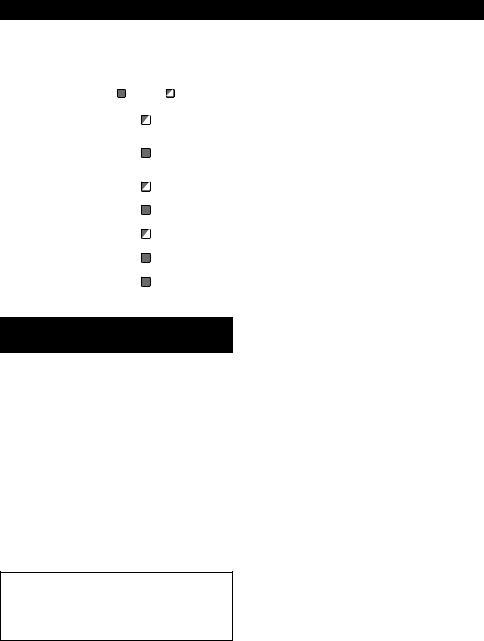
Description of the wireless activation lamp status
► Fig.52: 1. Wireless activation lamp
The wireless activation lamp shows the status of the wireless activation function. Refer to the table below for the meaning of the lamp status.
Status |
|
Wireless activation lamp |
Description |
|||
|
Color |
|
|
|
Duration |
|
|
|
On |
|
Blinking |
|
|
Standby |
Blue |
|
|
|
2 hours |
The wireless activation of the vacuum cleaner is available. The |
|
|
|
|
|
|
lamp will automatically turn off when no operation is performed |
|
|
|
|
|
|
for 2 hours. |
|
|
|
|
|
When |
The wireless activation of the vacuum cleaner is available and the |
|
|
|
|
|
the tool is |
tool is running. |
|
|
|
|
|
running. |
|
Tool |
Green |
|
|
|
20 seconds |
Ready for the tool registration. Waiting for the registration by the |
registration |
|
|
|
|
|
vacuum cleaner. |
|
|
|
|
|
2 seconds |
The tool registration has been finished. The wireless activation |
|
|
|
|
|
|
lamp will start blinking in blue. |
Cancelling |
Red |
|
|
|
20 seconds |
Ready for the cancellation of the tool registration. Waiting for the |
tool |
|
|
|
|
|
cancellation by the vacuum cleaner. |
registration |
|
|
|
|
2 seconds |
The cancellation of the tool registration has been finished. The |
|
|
|
|
|
||
|
|
|
|
|
|
wireless activation lamp will start blinking in blue. |
Others |
Red |
|
|
|
3 seconds |
The power is supplied to the wireless unit and the wireless activa- |
|
|
|
|
|
|
tion function is starting up. |
|
Off |
- |
|
- |
The wireless activation of the vacuum cleaner is stopped. |
|
Cancelling tool registration for the vacuum cleaner
Perform the following procedure when cancelling the tool registration for the vacuum cleaner.
1.Install the batteries to the vacuum cleaner and the
tool.
2.Set the stand-by switch on the vacuum cleaner to "AUTO".
► Fig.53: 1. Stand-by switch
3.Press the wireless activation button on the vacuum cleaner for 6 seconds. The wireless activation lamp blinks in green and then become red. After that, press the wireless activation button on the tool in the same way.
► Fig.54: 1. Wireless activation button 2. Wireless activation lamp
If the cancellation is performed successfully, the wireless activation lamps will light up in red for 2 seconds and start blinking in blue.
NOTE: The wireless activation lamps finish blinking in red after 20 seconds elapsed. Press the wireless activation button on the tool while the wireless activation lamp on the cleaner is blinking. If the wireless activation lamp does not blink in red, push the wireless activation button briefly and hold it down again.
21 ENGLISH

Troubleshooting for wireless activation function
Before asking for repairs, conduct your own inspection first. If you find a problem that is not explained in the manual, do not attempt to dismantle the tool. Instead, ask Makita Authorized Service Centers, always using Makita replacement parts for repairs.
State of abnormality |
Probable cause (malfunction) |
Remedy |
The wireless activation lamp does |
The wireless unit is not installed into the tool. |
Install the wireless unit correctly. |
not light/blink. |
The wireless unit is improperly installed |
|
|
into the tool. |
|
|
The terminal of the wireless unit and/or |
Gently wipe off dust and dirt on the terminal of the |
|
the slot is dirty. |
wireless unit and clean the slot. |
|
The wireless activation button on the |
Push the wireless activation button on the tool |
|
tool has not been pushed. |
briefly. |
|
The stand-by switch on the vacuum |
Set the stand-by switch on the vacuum cleaner to |
|
cleaner is not set to "AUTO". |
"AUTO". |
|
No power supply |
Supply the power to the tool and the vacuum cleaner. |
Cannot finish tool registration / can- |
The wireless unit is not installed into the tool. |
Install the wireless unit correctly. |
celling tool registration successfully. |
The wireless unit is improperly installed |
|
|
into the tool. |
|
|
The terminal of the wireless unit and/or |
Gently wipe off dust and dirt on the terminal of the |
|
the slot is dirty. |
wireless unit and clean the slot. |
|
The stand-by switch on the vacuum |
Set the stand-by switch on the vacuum cleaner to |
|
cleaner is not set to "AUTO". |
"AUTO". |
|
No power supply |
Supply the power to the tool and the vacuum cleaner. |
|
Incorrect operation |
Push the wireless activation button briefly and perform |
|
|
the tool registration/cancellation procedures again. |
|
The tool and vacuum cleaner are away |
Get the tool and vacuum cleaner closer to each other. The |
|
from each other (out of the transmission |
maximum transmission distance is approximately 10 m |
|
range). |
however it may vary according to the circumstances. |
|
Before finishing the tool registration/ |
Push the wireless activation button briefly and |
|
cancellation; |
perform the tool registration/cancellation procedures |
|
- the switch trigger on the tool is pulled or; |
again. |
|
- the power button on the vacuum |
|
|
cleaner is turned on. |
|
|
The tool registration procedures for |
Perform the tool registration procedures for both the |
|
the tool or vacuum cleaner have not |
tool and the vacuum cleaner at the same timing. |
|
finished. |
|
|
Radio disturbance by other appliances |
Keep the tool and vacuum cleaner away from the |
|
which generate high-intensity radio |
appliances such as Wi-Fi devices and microwave |
|
waves. |
ovens. |
The vacuum cleaner does not run |
The wireless unit is not installed into the tool. |
Install the wireless unit correctly. |
along with the switch operation of |
The wireless unit is improperly installed |
|
the tool. |
into the tool. |
|
|
The terminal of the wireless unit and/or |
Gently wipe off dust and dirt on the terminal of the |
|
the slot is dirty. |
wireless unit and clean the slot. |
|
The wireless activation button on the |
Push the wireless activation button briefly and make |
|
tool has not been pushed. |
sure that the wireless activation lamp is blinking in blue. |
|
The stand-by switch on the vacuum |
Set the stand-by switch on the vacuum cleaner to |
|
cleaner is not set to "AUTO". |
"AUTO". |
|
More than 10 tools are registered to the |
Perform the tool registration again. |
|
vacuum cleaner. |
If more than 10 tools are registered to the vacuum cleaner, |
|
|
the tool registered earliest will be cancelled automatically. |
|
The vacuum cleaner erased all tool |
Perform the tool registration again. |
|
registrations. |
|
|
No power supply |
Supply the power to the tool and the vacuum cleaner. |
|
The tool and vacuum cleaner are away |
Get the tool and vacuum cleaner closer each other. The |
|
from each other (out of the transmission |
maximum transmission distance is approximately 10 m |
|
range). |
however it may vary according to the circumstances. |
|
Radio disturbance by other appliances |
Keep the tool and vacuum cleaner away from the appli- |
|
which generate high-intensity radio waves. |
ances such as Wi-Fi devices and microwave ovens. |
The vacuum cleaner runs while the |
Other users are using the wireless |
Turn off the wireless activation button of the other |
tool's switch trigger is not pulled. |
activation of the vacuum cleaner with |
tools or cancel the tool registration of the other |
|
their tools. |
tools. |
22 ENGLISH

MAINTENANCE
 CAUTION: Always be sure that the tool is switched off and the battery cartridge is removed before attempting to perform inspection or maintenance.
CAUTION: Always be sure that the tool is switched off and the battery cartridge is removed before attempting to perform inspection or maintenance.
NOTICE: Never use gasoline, benzine, thinner, alcohol or the like. Discoloration, deformation or cracks may result.
To maintain product SAFETY and RELIABILITY, repairs, any other maintenance or adjustment should be performed by Makita Authorized or Factory Service Centers, always using Makita replacement parts.
Replacing filter of dust case
Optional accessory
1.Remove the dust case while pressing down the lever of the dust case.
► Fig.55: 1. Lever
2.Insert the flat-blade screwdriver into the slots of the filter cover to remove the filter cover.
► Fig.56: 1. Flat-blade screwdriver 2. Filter cover
3.Remove the filter from the filter case.
► Fig.57: 1. Filter 2. Filter case
4.Attach a new filter to the filter case, and then attach the filter cover.
5.Close the cover of the dust case, and then attach the dust case to the dust collection system.
Replacing sealing cap
Optional accessory
If the sealing cap is worn out, the performance of the dust collection decreases. Replace it if it's worn out. Remove the sealing cap, and then attach a new one with its protrusion facing upward.
► Fig.58: 1. Protrusion 2. Sealing cap
OPTIONAL ACCESSORIES
 CAUTION: These accessories or attachments are recommended for use with your Makita tool specified in this manual. The use of any other accessories or attachments might present a risk of injury to persons. Only use accessory or attachment for its stated purpose.
CAUTION: These accessories or attachments are recommended for use with your Makita tool specified in this manual. The use of any other accessories or attachments might present a risk of injury to persons. Only use accessory or attachment for its stated purpose.
If you need any assistance for more details regarding these accessories, ask your local Makita Service Center.
•Carbide-tipped drill bits (SDS-Plus carbide-tipped bits)
•Core bit
•Bull point
•Diamond core bit
•Cold chisel
•Scaling chisel
•Grooving chisel
•Chuck adapter
•Keyless drill chuck
•Bit grease
•Depth gauge
•Blow-out bulb
•Dust cup
•Dust cup set
•Dust collection system
•Wireless unit
•Hook
•Tool hanger
•Makita genuine battery and charger
•Safety goggles
•Plastic carrying case
NOTE: Some items in the list may be included in the tool package as standard accessories. They may differ from country to country.
23 ENGLISH

FRANÇAIS (Instructions originales)
SPÉCIFICATIONS
Modèle : |
|
DHR182 |
Capacités |
Béton |
18 mm |
|
Trépan |
35 mm |
|
Trépan diamant (type sec) |
32 mm |
|
Acier |
13 mm |
|
Bois |
24 mm |
Vitesse à vide |
|
0 - 1 350 min-1 |
Frappes par minute |
|
0 - 5 000 min-1 |
Longueur totale |
|
301 mm |
Tension nominale |
|
18 V CC |
Poids net |
|
2,4 - 3,2 kg |
Accessoire en option |
|
|
Modèle : |
DX05 |
Performance d’aspiration |
250 l/min |
Course de travail |
Jusqu’à 90 mm |
Foret adéquat |
Jusqu’à 160 mm |
Poids net |
0,9 kg |
•Étant donné l’évolution constante de notre programme de recherche et de développement, les spécifications contenues dans ce manuel sont sujettes à modification sans préavis.
•Les spécifications et la batterie peuvent être différentes suivant les pays.
•Le poids peut être différent selon les accessoires, notamment la batterie. Les associations la plus légère et la plus lourde, conformément à la procédure EPTA 01/2014, sont indiquées dans le tableau.
Batterie applicable
BL1815N / BL1820 / BL1820B / BL1830 / BL1830B / BL1840 / BL1840B / BL1850 / BL1850B / BL1860B
•Certaines batteries répertoriées ci-dessus peuvent ne pas être disponibles selon la région où vous résidez.
 AVERTISSEMENT : N’utilisez que les batteries répertoriées ci-dessus. L’utilisation de n’importe quelle autre batterie peut provoquer des blessures et/ou un incendie.
AVERTISSEMENT : N’utilisez que les batteries répertoriées ci-dessus. L’utilisation de n’importe quelle autre batterie peut provoquer des blessures et/ou un incendie.
Utilisation prévue
L’outil est conçu pour le perçage avec martelage et le perçage dans la brique, le béton et la pierre, ainsi que pour les tâches de ciselage.
Il convient également au perçage sans impact dans le bois, le métal, la céramique et le plastique.
Bruit
Niveau de bruit pondéré A typique, déterminé selon EN60745-2-6 :
Modèle DHR182
Niveau de pression sonore (LpA) : 89 dB (A) Niveau de puissance sonore (LWA ) : 100 dB (A) Incertitude (K) : 3 dB (A)
Modèle DHR182 avec DX05
Niveau de pression sonore (LpA) : 90 dB (A) Niveau de puissance sonore (LWA ) : 101 dB (A) Incertitude (K) : 3 dB (A)
NOTE : La ou les valeurs d’émission de bruit déclarées ont été mesurées conformément à la méthode de test standard et peuvent être utilisées pour comparer les outils entre eux.
NOTE : La ou les valeurs d’émission de bruit déclarées peuvent aussi être utilisées pour l’évaluation préliminaire de l’exposition.
 AVERTISSEMENT : Portez un serre-tête antibruit.
AVERTISSEMENT : Portez un serre-tête antibruit.
 AVERTISSEMENT : L’émission de bruit lors de l’usage réel de l’outil électrique peut être différente de la ou des valeurs déclarées, suivant la façon dont l’outil est utilisé, particulièrement selon le type de pièce usinée.
AVERTISSEMENT : L’émission de bruit lors de l’usage réel de l’outil électrique peut être différente de la ou des valeurs déclarées, suivant la façon dont l’outil est utilisé, particulièrement selon le type de pièce usinée.
 AVERTISSEMENT : Les mesures de sécurité à prendre pour protéger l’utilisateur doivent être basées sur une estimation de l’exposition dans des conditions réelles d’utilisation (en tenant compte de toutes les composantes du cycle d’utilisation, comme par exemple le moment de sa mise hors tension, lorsqu’il tourne à vide et le moment de son déclenchement).
AVERTISSEMENT : Les mesures de sécurité à prendre pour protéger l’utilisateur doivent être basées sur une estimation de l’exposition dans des conditions réelles d’utilisation (en tenant compte de toutes les composantes du cycle d’utilisation, comme par exemple le moment de sa mise hors tension, lorsqu’il tourne à vide et le moment de son déclenchement).
24 FRANÇAIS

Vibrations
Le tableau suivant indique la valeur totale de vibrations (somme de vecteur triaxial) déterminée selon la norme applicable.
Mode de travail |
Émission de vibrations |
Incertitude (K) |
Norme applicable |
Perçage avec martelage dans le béton (ah, HD) |
11,0 m/s2 |
1,5 m/s2 |
EN60745-2-6 |
Perçage avec martelage dans le béton avec le DX05 (ah, HD) |
11,0 m/s2 |
1,5 m/s2 |
EN60745-2-6 |
Fonction de ciselage avec poignée latérale (ah, Cheq) |
9,0 m/s2 |
1,5 m/s2 |
EN60745-2-6 |
Perçage dans le métal (ah, D) |
2,5 m/s2 |
1,5 m/s2 |
EN60745-2-1 |
NOTE : La ou les valeurs de vibration totales déclarées ont été mesurées conformément à la méthode de test standard et peuvent être utilisées pour comparer les outils entre eux.
NOTE : La ou les valeurs de vibration totales déclarées peuvent aussi être utilisées pour l’évaluation préliminaire de l’exposition.
 AVERTISSEMENT : L’émission de vibrations lors de l’usage réel de l’outil électrique peut être différente de la ou des valeurs déclarées, suivant la façon dont l’outil est utilisé, particulièrement selon le type de pièce usinée.
AVERTISSEMENT : L’émission de vibrations lors de l’usage réel de l’outil électrique peut être différente de la ou des valeurs déclarées, suivant la façon dont l’outil est utilisé, particulièrement selon le type de pièce usinée.
 AVERTISSEMENT : Les mesures de sécurité à prendre pour protéger l’utilisateur doivent être basées sur une estimation de l’exposition dans des conditions réelles d’utilisation (en tenant compte de toutes les composantes du cycle d’utilisation, comme par exemple le moment de sa mise hors tension, lorsqu’il tourne à vide et le moment de son déclenchement).
AVERTISSEMENT : Les mesures de sécurité à prendre pour protéger l’utilisateur doivent être basées sur une estimation de l’exposition dans des conditions réelles d’utilisation (en tenant compte de toutes les composantes du cycle d’utilisation, comme par exemple le moment de sa mise hors tension, lorsqu’il tourne à vide et le moment de son déclenchement).
Déclaration de conformité CE
Pour les pays européens uniquement
La déclaration de conformité CE est fournie en Annexe A à ce mode d’emploi.
CONSIGNES DE SÉCURITÉ
Consignes de sécurité générales pour outils électriques
 AVERTISSEMENT : Veuillez lire les consignes de sécurité, instructions, illustrations et spécifications qui accompagnent cet outil
AVERTISSEMENT : Veuillez lire les consignes de sécurité, instructions, illustrations et spécifications qui accompagnent cet outil
électrique. Le non-respect de toutes les instructions indiquées ci-dessous peut entraîner une électrocution, un incendie et/ou de graves blessures.
Conservez toutes les mises en garde et instructions pour référence ultérieure.
Le terme « outil électrique » dans les avertissements fait référence à l’outil électrique alimenté par le secteur (avec cordon d’alimentation) ou à l’outil électrique fonctionnant sur batterie (sans cordon d’alimentation).
CONSIGNES DE SÉCURITÉ POUR PERFORATEUR SANS FIL
1.Portez des protecteurs d’oreilles. L’exposition au bruit peut entraîner la surdité.
2.Utilisez la ou les poignées auxiliaires, si l’outil en possède. Toute perte de maîtrise de l’outil comporte un risque de blessure.
3.Tenez l’outil électrique par des surfaces de prise isolées lorsque vous effectuez une tâche au cours de laquelle l’accessoire de coupe peut entrer en contact avec des fils cachés. Le contact de l’accessoire de découpe avec un fil sous tension peut transmettre du courant dans les pièces métalliques exposées de l’outil électrique et électrocuter l’utilisateur.
4.Portez un casque de sécurité (casque de chantier), des lunettes de sécurité et/ou un écran facial. Les lunettes de vue ou les lunettes de soleil NE sont PAS des lunettes de sécurité. Il est également vivement recommandé de porter un masque anti-poussière et des gants matelassés.
5.Avant utilisation, assurez-vous que le foret est bien fixé en place.
6.Dans des conditions normales de fonctionnement, l’outil est conçu pour émettre des vibrations. Les vis peuvent se desserrer facilement et provoquer une panne ou un accident. Avant utilisation, vérifiez soigneusement que les vis sont bien serrées.
7.Par temps froid ou si l’outil n’a pas été utilisé pendant longtemps, laissez-le chauffer un instant en le faisant fonctionner à vide. Cela ramollira le lubrifiant. Si vous ne chauffez pas adéquatement l’outil, le martelage s’exécutera difficilement.
8.Assurez-vous toujours de travailler en position stable. Veillez à ce que personne ne se trouve en dessous de vous quand vous utilisez l’outil en hauteur.
9.Tenez l’outil fermement à deux mains.
10.Éloignez les mains des pièces en mouvement.
11.Ne vous éloignez pas en laissant l’outil tourner. Ne le faites fonctionner que lorsque vous l’avez bien en main.
12.Ne pointez l’outil vers personne dans la zone d’utilisation. Le foret peut être projeté et blesser gravement quelqu’un.
13.Ne touchez pas le foret, les pièces proches du foret ou la pièce immédiatement après l’exécution du travail ; ils peuvent être extrêmement chauds et vous brûler la peau.
25 FRANÇAIS

14.Certains matériaux contiennent des produits chimiques qui peuvent être toxiques. Prenez garde de ne pas avaler la poussière et évitez tout contact avec la peau. Suivez les données de sécurité du fournisseur du matériau.
15.Assurez-vous toujours que l’outil est hors tension et que la batterie et le foret sont retirés avant de passer l’outil à une autre personne.
CONSERVEZ CES INSTRUCTIONS.
 AVERTISSEMENT : NE vous laissez PAS tromper (au fil d’une utilisation répétée) par un sentiment d’aisance et de familiarité avec le produit, en négligeant le respect rigoureux des consignes de sécurité qui accompagnent le produit en question. La MAUVAISE UTILISATION de l’outil ou l’ignorance des consignes de sécurité indiquées dans ce mode d’emploi peut entraîner de graves blessures.
AVERTISSEMENT : NE vous laissez PAS tromper (au fil d’une utilisation répétée) par un sentiment d’aisance et de familiarité avec le produit, en négligeant le respect rigoureux des consignes de sécurité qui accompagnent le produit en question. La MAUVAISE UTILISATION de l’outil ou l’ignorance des consignes de sécurité indiquées dans ce mode d’emploi peut entraîner de graves blessures.
Consignes de sécurité importantes pour la batterie
1.Avant d’utiliser la batterie, lisez toutes les instructions et précautions relatives (1) au chargeur de batterie, (2) à la batterie, et (3) au produit utilisant la batterie.
2.Ne démontez pas la batterie.
3.Cessez immédiatement l’utilisation si le temps de fonctionnement devient excessivement court. Il y a risque de surchauffe, de brûlures, voire d’explosion.
4.Si l’électrolyte pénètre dans vos yeux, rincez-les
àl’eau claire et consultez immédiatement un médecin. Il y a risque de perte de la vue.
5.Ne court-circuitez pas la batterie :
(1)Ne touchez les bornes avec aucun matériau conducteur.
(2)Évitez de ranger la batterie dans un conteneur avec d’autres objets métalliques, par exemple des clous, des pièces de monnaie, etc.
(3)N’exposez pas la batterie à l’eau ou à la pluie. Un court-circuit de la batterie peut provoquer une intensité de courant élevée, une surchauffe, parfois des brûlures et même une panne.
6.Ne rangez pas l’outil et la batterie dans un endroit où la température risque d’atteindre ou de dépasser 50 °C.
7.Ne jetez pas la batterie au feu même si elle est sérieusement endommagée ou complètement épuisée. La batterie peut exploser au contact du feu.
8.Évitez de laisser tomber ou de cogner la batterie.
9.N’utilisez pas la batterie si elle est endommagée.
10.Les batteries au lithium-ion contenues sont soumises aux exigences de la législation sur les marchandises dangereuses.
Lors du transport commercial par des tierces parties ou des transitaires par exemple, des exigences spécifiques en matière d’étiquetage et d’emballage doivent être respectées.
Pour la préparation de l’article expédié, il est nécessaire de consulter un expert en matériau dangereux. Veuillez également respecter les réglementations nationales susceptibles d’être plus détaillées.
Recouvrez les contacts exposés avec du ruban adhésif ou du ruban de masquage et emballez la batterie de telle sorte qu’elle ne puisse pas bouger dans l’emballage.
11.Suivez les réglementations locales en matière de mise au rebut des batteries.
12.Utilisez les batteries uniquement avec les produits spécifiés par Makita. L’insertion de batteries dans des produits non conformes peut provoquer un incendie, une chaleur excessive, une explosion ou une fuite de l’électrolyte.
CONSERVEZ CES INSTRUCTIONS.
 ATTENTION : N’utilisez que des batteries Makita d’origine. L’utilisation de batteries de marque autre que Makita ou de batteries modifiées peut provoquer l’explosion des batteries, ce qui présente un risque d’incendie, de dommages matériels et corporels. Cela annulera également la garantie Makita pour l’outil et le chargeur Makita.
ATTENTION : N’utilisez que des batteries Makita d’origine. L’utilisation de batteries de marque autre que Makita ou de batteries modifiées peut provoquer l’explosion des batteries, ce qui présente un risque d’incendie, de dommages matériels et corporels. Cela annulera également la garantie Makita pour l’outil et le chargeur Makita.
Conseils pour assurer la durée de vie optimale de la batterie
1.Chargez la batterie avant qu’elle ne soit complètement déchargée. Arrêtez toujours l’outil et rechargez la batterie quand vous remarquez que la puissance de l’outil diminue.
2.Ne rechargez jamais une batterie complètement chargée. La surcharge réduit la durée de service de la batterie.
3.Chargez la batterie à une température ambiante comprise entre 10 °C et 40 °C. Avant de charger une batterie chaude, laissez-la refroidir.
4.Rechargez la batterie si elle est restée inutilisée pendant une période prolongée (plus de six mois).
Consignes de sécurité importantes pour le connecteur sans fil
1.Ne démontez ni ne modifiez le connecteur sans fil.
2.Conservez le connecteur sans fil hors de portée des jeunes enfants. En cas d’ingestion accidentelle, consultez immédiatement un médecin.
3.Utilisez le connecteur sans fil uniquement avec des outils Makita.
4.N’exposez pas le connecteur sans fil à la pluie ou à l’humidité.
5.N’utilisez pas le connecteur sans fil dans un endroit où la température dépasse 50 °C.
6.Ne faites pas fonctionner le connecteur sans fil dans un endroit où des appareils médicaux comme des simulateurs cardiaques sont utilisés.
7.Ne faites pas fonctionner le connecteur sans fil dans un endroit où des appareils automatiques sont utilisés. Sinon, ces appareils pourraient présenter un dysfonctionnement ou une erreur.
8.N’utilisez pas le connecteur sans fil dans un endroit à température élevée ou dans un endroit susceptible de générer de l’électricité statique ou du bruit électrique.
26 FRANÇAIS

9.Le connecteur sans fil peut produire des champs électromagnétiques (CEM), mais ceux-ci ne sont pas dangereux pour l’utilisateur.
10.Le connecteur sans fil est un instrument de précision. Évitez de laisser tomber ou de cogner le connecteur sans fil.
11.Évitez de toucher la borne du connecteur sans fil avec les mains nues ou avec des objets métalliques.
12.Retirez toujours la batterie du produit avant d’y installer le connecteur sans fil.
13.Évitez d’ouvrir le couvercle de la fente dans un endroit où de la poussière ou de l’eau pourrait pénétrer dans la fente. Maintenez toujours propre l’entrée de la fente.
14.Insérez toujours le connecteur sans fil dans le bon sens.
15.N’appuyez pas trop fort sur le bouton d’activation sans fil du connecteur sans fil, ni n’appuyez dessus avec un objet pointu.
16.Fermez toujours le couvercle de la fente pendant le fonctionnement.
17.Ne retirez pas le connecteur sans fil de la fente alors que l’outil est sous tension. Vous risqueriez de provoquer un dysfonctionnement du connecteur sans fil.
18.Ne retirez pas l’autocollant du connecteur sans fil.
19.Ne placez pas d’autocollant sur le connecteur sans fil.
20.Ne laissez pas le connecteur sans fil dans un endroit susceptible de générer de l’électricité statique ou du bruit électrique.
21.Ne laissez pas le connecteur sans fil dans un endroit soumis à une forte chaleur, comme une voiture en plein soleil.
22.Ne laissez pas le connecteur sans fil dans un endroit poussiéreux ou sablonneux ou dans un endroit susceptible de générer des gaz corrosifs.
23.De la condensation peut se former sur le connecteur sans fil en cas de brusque changement de température. N’utilisez pas le connecteur sans fil tant que la condensation n’a pas complètement séché.
24.Pour nettoyer le connecteur sans fil, essuyez-le délicatement avec un chiffon doux et sec. N’utilisez pas de benzine, diluant, graisse conductrice ou autre.
25.Rangez le connecteur sans fil en le conservant dans l’étui fourni ou dans un récipient anti-statique.
26.N’insérez pas d’autres dispositifs que le connecteur sans fil Makita dans la fente sur l’outil.
27.N’utilisez pas l’outil si le couvercle de la fente est endommagé. L’eau, la poussière ou la saleté pourraient pénétrer dans la fente provoquant un dysfonctionnement.
28.Ne tirez, ni ne tordez plus que nécessaire le couvercle de la fente. Remettez le couvercle en place s’il se détache de l’outil.
29.Remplacez le couvercle de la fente si vous le perdez ou l’endommagez.
CONSERVEZ CES INSTRUCTIONS.
DESCRIPTION DU FONCTIONNEMENT
 ATTENTION : Assurez-vous toujours que l’outil est hors tension et que sa batterie est retirée avant de l’ajuster ou de vérifier son fonctionnement.
ATTENTION : Assurez-vous toujours que l’outil est hors tension et que sa batterie est retirée avant de l’ajuster ou de vérifier son fonctionnement.
Insertion ou retrait de la batterie
 ATTENTION : Éteignez toujours l’outil avant de mettre en place ou de retirer la batterie.
ATTENTION : Éteignez toujours l’outil avant de mettre en place ou de retirer la batterie.
 ATTENTION : Tenez fermement l’outil et la batterie lors de la mise en place ou du retrait de la batterie. Si vous ne tenez pas fermement l’outil et la batterie, ils peuvent vous glisser des mains, et s’abîmer ou vous blesser.
ATTENTION : Tenez fermement l’outil et la batterie lors de la mise en place ou du retrait de la batterie. Si vous ne tenez pas fermement l’outil et la batterie, ils peuvent vous glisser des mains, et s’abîmer ou vous blesser.
► Fig.1: 1. Voyant rouge 2. Bouton 3. Batterie
Pour retirer la batterie, faites-la glisser hors de l’outil tout en faisant glisser le bouton à l’avant de la batterie.
Pour mettre en place la batterie, alignez la languette sur la batterie avec la rainure sur le compartiment et insérez-la.
Insérez-la à fond jusqu’à ce qu’un léger déclic se fasse entendre. Si le voyant rouge sur le dessus du bouton est visible, cela signifie qu’elle n’est pas bien verrouillée.
 ATTENTION : Insérez toujours complètement la batterie jusqu’à ce que le voyant rouge ne soit plus visible.
ATTENTION : Insérez toujours complètement la batterie jusqu’à ce que le voyant rouge ne soit plus visible.
Sinon, elle pourrait tomber accidentellement de l’outil, au risque de vous blesser ou de blesser quelqu’un se trouvant près de vous.
 ATTENTION : N’insérez pas la batterie de force. Si elle ne glisse pas facilement, c’est que vous ne l’insérez pas correctement.
ATTENTION : N’insérez pas la batterie de force. Si elle ne glisse pas facilement, c’est que vous ne l’insérez pas correctement.
Indication de la charge restante de la batterie
Uniquement pour les batteries avec voyant lumineux
► Fig.2: 1. Témoins 2. Bouton de vérification
Appuyez sur le bouton de vérification sur la batterie pour indiquer la charge restante de la batterie. Les témoins s’allument pendant quelques secondes.
|
Témoins |
Charge |
|
|
restante |
Allumé |
Éteint |
Clignotant |
|
|
75 % à 100 % |
|
|
50 % à 75 % |
|
|
25 % à 50 % |
|
|
0 % à 25 % |
|
|
Chargez la |
|
|
batterie. |
|
|
Anomalie |
|
|
possible |
|
|
de la batterie. |
27 FRANÇAIS

NOTE : Selon les conditions d’utilisation et la température ambiante, l’indication peut être légèrement différente de la capacité réelle.
Système de protection de l’outil/la batterie
L’outil est équipé d’un système de protection de l’outil/la batterie. Ce système coupe automatiquement l’alimentation vers le moteur pour prolonger la durée de vie de l’outil et de la batterie. Si l’outil ou la batterie se trouve dans l’une des situations suivantes, l’outil cessera automatiquement de fonctionner.
Protection contre la surcharge
Lorsque la batterie est utilisée d’une manière provoquant un appel de courant anormalement élevé, l’outil s’arrête automatiquement sans indication. Dans ce cas, éteignez l’outil et arrêtez la tâche ayant provoqué la surcharge de l’outil. Puis rallumez l’outil pour reprendre la tâche.
Protection contre la surchauffe
En cas de surchauffe de l’outil ou de la batterie, l’outil s’arrête automatiquement. Dans ce cas, laissez l’outil et la batterie refroidir avant de rallumer l’outil.
NOTE : Si l’outil surchauffe, la lampe clignote.
Protection contre la décharge totale de la batterie
Lorsque la charge de la batterie est insuffisante, l’outil s’arrête automatiquement. Dans ce cas, retirez la batterie de l’outil et chargez-la.
Fonctionnement de la gâchette
 AVERTISSEMENT : Avant d’insérer la batterie dans l’outil, vérifiez toujours que la gâchette fonctionne bien et revient en position d’arrêt lorsque vous la relâchez.
AVERTISSEMENT : Avant d’insérer la batterie dans l’outil, vérifiez toujours que la gâchette fonctionne bien et revient en position d’arrêt lorsque vous la relâchez.
► Fig.3: 1. Gâchette
Il suffit d’enclencher la gâchette pour démarrer l’outil.
La vitesse de l’outil augmente à mesure que l’on accroît la pression exercée sur la gâchette. Pour l’arrêter, relâchez la gâchette.
Allumage de la lampe avant
► Fig.4: 1. Lampe
 ATTENTION : Évitez de regarder directement le faisceau lumineux ou sa source.
ATTENTION : Évitez de regarder directement le faisceau lumineux ou sa source.
Enclenchez la gâchette pour allumer la lampe. La lampe reste allumée tant que la gâchette est enclenchée. La lampe s’éteint environ 10 secondes après avoir relâché la gâchette.
NOTE : Retirez la saleté sur la lentille de la lampe avec un chiffon sec. Prenez soin de ne pas érafler la lentille de la lampe sous peine de diminuer son éclairage.
Fonctionnement de l’inverseur
► Fig.5: 1. Levier de l’inverseur
 ATTENTION : Vérifiez toujours le sens de rotation avant d’utiliser l’outil.
ATTENTION : Vérifiez toujours le sens de rotation avant d’utiliser l’outil.
 ATTENTION : N’utilisez l’inverseur qu’une fois que l’outil est complètement arrêté. Si vous changez le sens de rotation avant l’arrêt de l’outil, vous risquez de l’endommager.
ATTENTION : N’utilisez l’inverseur qu’une fois que l’outil est complètement arrêté. Si vous changez le sens de rotation avant l’arrêt de l’outil, vous risquez de l’endommager.
 ATTENTION : Lorsque vous n’utilisez pas l’outil, placez toujours le levier de l’inverseur en position neutre.
ATTENTION : Lorsque vous n’utilisez pas l’outil, placez toujours le levier de l’inverseur en position neutre.
L’outil possède un inverseur qui permet de changer le sens de rotation. Enfoncez le levier de l’inverseur du côté A pour une rotation dans le sens des aiguilles d’une montre, ou du côté B pour une rotation dans le sens inverse des aiguilles d’une montre.
La gâchette ne peut pas être enclenchée lorsque le levier de l’inverseur se trouve en position neutre.
Sélection du mode de fonctionnement
REMARQUE : Ne tournez pas le bouton de changement de mode pendant que l’outil fonctionne. L’outil serait endommagé.
REMARQUE : Pour éviter que le mécanisme de changement de mode ne s’use rapidement, vous devez toujours vous assurer que le bouton de changement de mode est placé avec exactitude sur l’une des trois positions du mode de fonctionnement.
Rotation avec martelage
Pour percer dans le béton, de la maçonnerie, etc., tournez le bouton de changement de mode jusqu’au
symbole  . Utilisez un foret à pointe en carbure de tungstène (accessoire en option).
. Utilisez un foret à pointe en carbure de tungstène (accessoire en option).
► Fig.6: 1. Rotation avec martelage 2. Bouton de changement de mode
Rotation uniquement
Pour percer dans le bois, le métal ou des matériaux en plastique, tournez le bouton de changement de mode
jusqu’au symbole  . Utilisez un foret hélicoïdal ou à bois.
. Utilisez un foret hélicoïdal ou à bois.
► Fig.7: 1. Rotation uniquement
Martelage uniquement
Pour le burinage, l’écaillage ou la démolition, tournez le
bouton de changement de mode jusqu’au symbole  . Utilisez un pic, un ciseau à froid, un ciseau à écailler, etc.
. Utilisez un pic, un ciseau à froid, un ciseau à écailler, etc.
► Fig.8: 1. Martelage uniquement
28 FRANÇAIS

Réglage de la position de la buse du système de collecte des poussières
Accessoire en option
Appuyez sur le guide tout en poussant vers le haut le bouton de réglage du guide, puis relâchez le bouton à la position souhaitée.
► Fig.9: 1. Guide 2. Bouton de réglage du guide
NOTE : Avant de régler la position de la buse, relâchez totalement la buse vers l’avant en poussant vers le haut le bouton de réglage du guide.
Réglage de la profondeur de perçage du système de collecte des poussières
Accessoire en option
Faites coulisser le bouton de réglage de la profondeur jusqu’à la position souhaitée en le poussant vers le haut. La distance (A) est la profondeur du perçage. ► Fig.10: 1. Bouton de réglage de la profondeur
Limiteur de couple
REMARQUE : Si le limiteur de couple se déclenche, éteignez immédiatement l’outil. Ceci permettra d’éviter l’usure prématurée de l’outil.
REMARQUE : Les forets, comme les scies cloches qui ont tendance à se coincer ou se prendre facilement dans le trou, ne sont pas appropriés pour cet outil. Ils déclenchent trop fréquemment le limiteur de couple.
Le limiteur de couple se déclenche lorsqu’un certain niveau de couple est atteint. Le moteur se dégage de l’arbre de sortie. Dans ce cas, le foret cesse de tourner.
Fonction électronique
L’outil est doté de fonctions électroniques pour en faciliter le fonctionnement.
•Contrôle de vitesse constante
La fonction de contrôle de la vitesse offre une vitesse de rotation constante quelles que soient les conditions de charge.
ASSEMBLAGE
 ATTENTION : Assurez-vous toujours que l’outil est hors tension et que sa batterie est retirée avant d’effectuer toute tâche dessus.
ATTENTION : Assurez-vous toujours que l’outil est hors tension et que sa batterie est retirée avant d’effectuer toute tâche dessus.
Poignée latérale (poignée auxiliaire)
 ATTENTION : Utilisez toujours la poignée latérale pour garantir votre sécurité.
ATTENTION : Utilisez toujours la poignée latérale pour garantir votre sécurité.
 ATTENTION : Après avoir mis en place ou réglé la poignée latérale, assurez-vous qu’elle est solidement fixée.
ATTENTION : Après avoir mis en place ou réglé la poignée latérale, assurez-vous qu’elle est solidement fixée.
Installez la poignée latérale de sorte que les rainures de la poignée pénètrent dans les parties saillantes du barillet de l’outil. Tournez la poignée dans le sens des aiguilles d’une montre pour la serrer en place. La poignée peut être fixée à l’angle souhaité.
► Fig.11: 1. Poignée latérale
Graisse
Enduisez au préalable l’extrémité de la tige du foret avec une petite quantité de graisse (environ 0,5 à 1 g).
Cette lubrification du mandrin garantit un mouvement fluide et prolonge la durée de vie utile.
Pose ou retrait du foret
Nettoyez l’extrémité de la tige du foret et appliquez de la graisse avant de poser le foret.
► Fig.12: 1. Extrémité de la tige 2. Graisse
Insérez le foret dans l’outil. Tournez le foret et enfon- cez-le jusqu’à ce qu’il s’engage.
Après avoir posé le foret, assurez-vous toujours qu’il est solidement maintenu en place en essayant de le sortir.
► Fig.13: 1. Foret
Pour retirer le foret, tirez le carter du mandrin à fond vers le bas puis dégagez le foret.
► Fig.14: 1. Foret 2. Carter du mandrin
Angle du burin (lors du burinage, de l’écaillage ou de la démolition)
Le burin peut être fixé à l’angle souhaité. Pour changer l’angle du burin, tournez le bouton de changement de mode jusqu’au symbole O. Tournez le burin sur l’angle souhaité.
► Fig.15: 1. Bouton de changement de mode
Tournez le bouton de changement de mode jusqu’au
symbole  . Puis assurez-vous toujours que le burin est solidement maintenu en place en le tournant légèrement.
. Puis assurez-vous toujours que le burin est solidement maintenu en place en le tournant légèrement.
Jauge de profondeur
La jauge de profondeur est utile pour percer des trous de même profondeur. Desserrez la poignée latérale et insérez la jauge de profondeur dans l’orifice sur la poignée latérale. Réglez la jauge de profondeur sur la profondeur désirée et serrez fermement la poignée latérale.
► Fig.16: 1. Orifice 2. Jauge de profondeur
NOTE : Assurez-vous que la jauge de profondeur n’entre pas en contact avec le corps principal de l’outil lorsque vous la fixez.
29 FRANÇAIS

Installation ou retrait du système de collecte des poussières
Accessoire en option
Pour retirer le système de collecte des poussières, tirez sur l’outil tout en appuyant sur le bouton de déverrouillage. Pour l’installer, insérez à fond l’outil dans le système de collecte des poussières, jusqu’à ce qu’il s’enclenche en émettant un petit clic.
► Fig.17: 1. Bouton de déverrouillage
Collecteur de poussières
Accessoire en option
Utilisez le collecteur de poussières pour éviter que la poussière ne tombe sur l’outil et sur vous-même lorsque vous percez au-dessus de votre tête. Fixez le collecteur de poussières au foret comme illustré sur la figure. Le collecteur de poussières peut être fixé aux forets des tailles suivantes.
Modèle |
Diamètre du foret |
Collecteur de poussières 5 |
6 mm à 14,5 mm |
Collecteur de poussières 9 |
12 mm à 16 mm |
► Fig.18: 1. Collecteur de poussières
Ensemble du collecteur de poussières
Accessoire en option
Installation de l’ensemble du collecteur de poussières
REMARQUE : Si vous achetez l’ensemble du collecteur de poussières en tant qu’accessoire en option, la poignée latérale standard ne peut pas être utilisée avec l’ensemble du collecteur de poussières installé sur l’outil. Lorsque l’ensemble du collecteur de poussières est installé sur l’outil, retirez la poignée de la poignée latérale standard, puis fixez-la sur l’ensemble poignée en option.
► Fig.19: 1. Boulon 2. Poignée 3. Ensemble poignée en option
REMARQUE : N’utilisez pas l’ensemble du collecteur de poussières lorsque vous percez dans le métal ou un matériau similaire. Vous risqueriez d’endommager l’ensemble du collecteur de poussières en raison de la chaleur produite par les petites poussières métalliques ou similaires. N’installez pas, ni ne retirez l’ensemble du collecteur de poussières avec le foret inséré sur l’outil. Vous risqueriez d’endommager l’ensemble du collecteur de poussières et de provoquer une fuite de la poussière.
Avant d’installer l’ensemble du collecteur de poussières, retirez le foret de l’outil le cas échéant.
1. Installez l’entretoise de sorte que les rainures de l’entretoise pénètrent dans les parties saillantes du barillet de l’outil lorsque vous l’écartez. Prenez garde que le ressort ne se détache pas de la fente de l’entretoise.
►Fig.20: 1. Entretoise 2. Ressort
►Fig.21
2.Installez la poignée latérale (ensemble poignée en option et poignée retirée de la poignée latérale standard) de sorte que la rainure de la poignée pénètre dans la partie saillante de l’entretoise. Tournez la poignée dans le sens des aiguilles d’une montre pour la serrer en place.
►Fig.22: 1. Poignée latérale
3.Installez l’ensemble du collecteur de poussières de sorte que les griffes du collecteur de poussières pénètrent dans les fentes de l’entretoise.
►Fig.23: 1. Collecteur de poussières 2. Griffes
NOTE : Si vous raccordez un aspirateur à l’ensemble du collecteur de poussières, retirez le bouchon à poussière avant de le raccorder.
► Fig.24: 1. Bouchon à poussière
Retrait du foret
Pour retirer le foret, tirez le carter du mandrin à fond vers le bas puis dégagez le foret.
► Fig.25: 1. Foret 2. Carter du mandrin
Retrait de l’ensemble du collecteur de poussières
Procédez comme il est indiqué ci-dessous pour retirer l’ensemble du collecteur de poussières.
1.Desserrez la poignée latérale. ► Fig.26: 1. Poignée latérale
2.Tenez la base du collecteur de poussières et sortez-le.
► Fig.27: 1. Collecteur de poussières
NOTE : S’il s’avère difficile de retirer l’ensemble du collecteur de poussières, retirez les griffes du collecteur de poussières une par une en balançant et tirant sa base.
NOTE : Si le bouchon se détache du collecteur de poussières, fixez-le avec le côté imprimé tourné vers le haut de sorte que la rainure sur le bouchon s’insère dans la périphérie interne de l’accessoire.
► Fig.28
Crochet
Accessoire en option
 ATTENTION : Retirez toujours la batterie lorsque l’outil est suspendu par son crochet.
ATTENTION : Retirez toujours la batterie lorsque l’outil est suspendu par son crochet.
 ATTENTION : N’accrochez jamais l’outil dans un emplacement élevé ou sur une surface potentiellement instable.
ATTENTION : N’accrochez jamais l’outil dans un emplacement élevé ou sur une surface potentiellement instable.
► Fig.29: 1. Rainure 2. Crochet 3. Vis
Le crochet est pratique pour suspendre provisoirement l’outil. Il s’installe d’un côté comme de l’autre de l’outil. Pour installer le crochet, insérez-le dans une rai-
nure du carter de l’outil sur l’un des deux côtés, puis fixez-le avec une vis. Pour le retirer, desserrez la vis et enlevez-le.
30 FRANÇAIS
